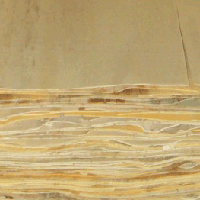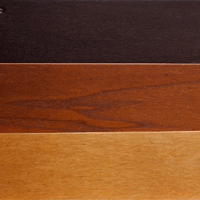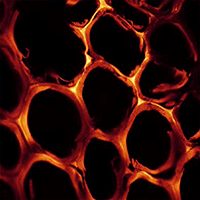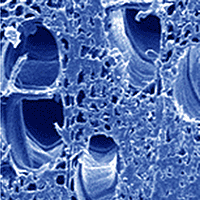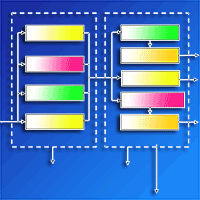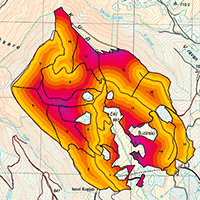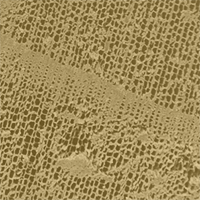How well modified wood products perform may be influenced by their chemical compositions. Wood extractives are nonstructural constituents, many with specific biological properties, which affect the color, fragrance, hygroscopicity, durability, and acoustic properties and the drying and adhesion processes of wood. However, incomplete information is available on the extraction techniques and potential use of extractives as value-added chemical products. The main goal of this research was to explore the effects of thermo-vacuum treatment of Deodar cedar (Cedrus deodara Roxb.) and Italian alder (Alnus cordata Desf.) woods on the content and composition of extractives. Solvents with different polarities were used, including water, hexane, dichloromethane, methanol, and a benzene/ethanol mixture. Component groups in extracts were determined by gas chromatography in combination with mass spectrometry. Regardless of the treatment and solvent, the most representative extracts to be obtained from alder were acids/esters, whereas hydrocarbons were most frequently obtained from cedar. Our results revealed an interesting differential species-specific effect of solvents on the composition of extracts. Aside from benzene/ethanol, greater amounts of extracts were obtained from treated than from untreated alder, whereas the opposite was true for cedar, aside from methanol.
Keywords
, , , ,
Citation
Lovaglio T, D’Auria M, Rita A, Todaro L (2017). Compositions of compounds extracted from thermo-treated wood using solvents of different polarities. iForest 10: 824-828. - doi: 10.3832/ifor2360-010
Academic Editor
Giacomo Goli
Paper history
Received: Jan 17, 2017
Accepted: Jul 04, 2017
First online: Sep 25, 2017
Publication Date: Oct 31, 2017
Publication Time: 2.77 months
© SISEF - The Italian Society of Silviculture and Forest Ecology 2017
Open Access
This article is distributed under the terms of the Creative Commons Attribution-Non Commercial 4.0 International (https://creativecommons.org/licenses/by-nc/4.0/), which permits unrestricted use, distribution, and reproduction in any medium, provided you give appropriate credit to the original author(s) and the source, provide a link to the Creative Commons license, and indicate if changes were made.

Breakdown by View Type
(Waiting for server response...)
Article Usage
Total Article Views: 49968
(from publication date up to now)
Breakdown by View Type
HTML Page Views: 41526
Abstract Page Views: 3233
PDF Downloads: 4015
Citation/Reference Downloads: 17
XML Downloads: 1177
Web Metrics
Days since publication: 3018
Overall contacts: 49968
Avg. contacts per week: 115.90
Article Citations
Article citations are based on data periodically collected from the Clarivate Web of Science web site
(last update: Mar 2025)
Total number of cites (since 2017): 16
Average cites per year: 1.78
Publication Metrics
by Dimensions ©
Articles citing this article
List of the papers citing this article based on CrossRef Cited-by.
(1)
Bhandarkar SS, Arbiser JL (2007)Curcumin as an inhibitor of angiogenesis. Advances in Experimental Medicine and Biology 595: 185-195.
CrossRef |
Gscholar
(2)
Bikovens O, Roze L, Pranovich A, Reunanen M, Telysheva G (2012)Chemical composition of lipophilic extractives from grey alder (
Alnus incana). BioResources 8 (1): 350-357.
CrossRef |
Gscholar
(3)
Boonstra MJ, Tjeerdsma B (2006)Chemical analysis of heat treated softwoods. Holz als Roh-und Werkstoff 64 (3): 204-211.
CrossRef |
Gscholar
(4)
Bortolomeazzi R, Sebastianutto N, Toniolo R, Pizzariello A (2007)Comparative evaluation of the antioxidant capacity of smoke flavouring phenols by crocin bleaching inhibition, DPPH radical scavenging and oxidation potential. Food Chemistry 100 (4): 1481-1489.
CrossRef |
Gscholar
(5)
Cadahía E, Fernández De Simón B, Jalocha J (2003)Volatile compounds in Spanish, French, and American oak woods after natural seasoning and toasting. Journal of Agricultural and Food Chemistry 51 (20): 5923-5932.
CrossRef |
Gscholar
(6)
Candelier K, Chaouch M, Dumarçay S, Pétrissans A, Pétrissans M, Gérardin P (2011)Utilization of thermodesorption coupled to GC-MS to study stability of different wood species to thermodegradation. Journal of Analytical and Applied Pyrolysis 92 (2): 376-383.
CrossRef |
Gscholar
(7)
Esteves B, Graca J, Pereira H (2008)Extractive composition and summative chemical analysis of thermally treated eucalypt wood. Holzforschung 62 (3): 344-351.
CrossRef |
Gscholar
(8)
Esteves B, Pereira H (2008)Wood modification by heat treatment: a review. BioResources 4 (1): 370-404.
Online |
Gscholar
(9)
Fache M, Boutevin B, Caillol S (2015)Vanillin production from lignin and its use as a renewable chemical. ACS Sustainable Chemistry and Engineering 4 (1): 35-46.
CrossRef |
Gscholar
(10)
Faix O, Meier D, Fortmann I (1990a)Thermal degradation products of wood. Holz als Roh-und Werkstoff 48 (7-8): 281-285.
CrossRef |
Gscholar
(11)
Faix O, Meier D, Fortmann I (1990b)Thermal degradation products of wood. Holz als Roh-und Werkstoff 48 (7-8): 351-354.
Gscholar
(12)
Fernandez MP, Watson PA, Breuil C (2001)Gas chromatography-mass spectrometry method for the simultaneous determination of wood extractive compounds in quaking aspen. Journal of Chromatography A 922 (1): 225-233.
CrossRef |
Gscholar
(13)
Ferrari S, Cuccui I, Allegretti O (2013)Thermo-vacuum modification of some European softwood and hardwood species treated at different conditions. BioResources 8 (1): 1100-1109.
Online |
Gscholar
(14)
González-Vila FJ, Gutiérrez A, Martin F, Verdejo T (1997)Application of analytical pyrolysis to the characterization of
Eucalyptus extractives and pitch deposits from a pulp mill. Journal of analytical and applied pyrolysis 40: 501-510.
CrossRef |
Gscholar
(15)
Hill CA (2007)Wood modification: chemical, thermal and other processes. John Wiley and Sons Ltd, Chichester, UK, pp. 260.
Online |
Gscholar
(16)
Ibrahim MNM, Balakrishnan RS, Shamsudeen S, Bahwani SA, Adam F (2012)A concise review of the natural existance, synthesis, properties, and applications of syringaldehyde. BioResources 7 (3): 4377-4399.
Online |
Gscholar
(17)
Kim GH, Yun KE, Kim JJ (1998)Effect of heat treatment on the decay resistance and the bending properties of radiata pine sapwood. Material und Organismen 32 (2): 101-108.
Online |
Gscholar
(18)
Kumar N, Pruthi V (2014)Potential applications of ferulic acid from natural sources. Biotechnology Reports 4: 86-93.
CrossRef |
Gscholar
(19)
Kuroyanagi M, Shimomae M, Nagashima Y, Muto N, Okuda T, Kawahara N, Nakane T, Sano T (2005)New diarylheptnoids from
Alnus japonica and their antioxadive activity. Chemical and pharmaceutical bulletin 53: 1519-1523.
CrossRef |
Gscholar
(20)
Kuttan G, Kumar KB, Guruvayoorappan C, Kuttan R (2007)Antitumor, anti-invasion, and antimetastatic effects of curcumin. Advances in Experimental Medicine and Biology 595: 173-184.
CrossRef |
Gscholar
(21)
Martinez RG, De La Serrana HLG, MirMV, Granados JQ, Martinez ML (1996)Influence of wood heat treatment, temperature and maceration time on vanillin, syringaldehyde, and gallic acid contents in oak wood and wine spirit mixtures. American Journal of Enology and Viticulture 47 (4): 441-446.
Online |
Gscholar
(22)
Nuopponen M, Vuorinen T, Jämsä S, Viitaniemi P (2003)The effects of heat treatment on the behaviour of extractives in softwood studied by FTIR spectroscopic methods. Wood Science and Technology 37: 109-115.
CrossRef |
Gscholar
(23)
Nuopponen M, Vuorinen T, Jämsä S, Viitaniemi P (2005)Thermal modifications in softwood studied by FTIR and UV resonance Raman spectroscopies. Journal of Wood Chemistry and Technology 24 (1): 13-26.
CrossRef |
Gscholar
(24)
Pari L, Tewas D, Eckel J (2008)Role of curcumin in health and disease. Archives of Physiology and Biochemistry 114 (2): 127-149.
CrossRef |
Gscholar
(25)
Poncsak S, Kocaefe D, Simard F, Pichette A (2009)Evolution of extractive composition during thermal treatment of Jack pine. Journal of Wood Chemistry and Technology 29 (3): 251-264.
CrossRef |
Gscholar
(26)
Rowe JW, Conner AH (1979)Extractives in eastern hardwoods: a review. General Technical Report FPL-18, USDA Forest Products Laboratory, Madison, WI, USA, pp. 1-45.
Online |
Gscholar
(27)
Roze L, Bikovens O, Telysheva G (2011)Determination and separation of diarylheptanoids from alder growing in Latvia. Environment, technology, resources. In: Proceedings of the “8th International Scientific and Practical Conference” (Ansone V ed). Rezekne (Latvia) 20-22 June 2011. Rezekne, Latvia, pp. 329-332.
Online |
Gscholar
(28)
Scheffer TC, Cowling FB (1966)Natural resistance of wood to microbial deterioration. Annual Review of Phytopathology 4 (1): 147-168.
CrossRef |
Gscholar
(29)
Sivonen H, Maunu SL, Sundholm F, Jämsä S, Viitaniemi P (2002)Magnetic resonance studies of thermally modified wood. Holzforschung 56 (6): 648-654.
CrossRef |
Gscholar
(30)
Stamm AJ (1956)Thermal degradation of wood and cellulose. Industrial and Engineering Chemistry 48 (3): 413-417.
CrossRef |
Gscholar
(31)
Strimpakos AS, Sharma RA (2008)Curcumin: preventive and therapeutic properties in laboratory studies and clinical trials. Antioxidants and Redox Signaling 10 (3): 511-545.
CrossRef |
Gscholar
(32)
Surh YJ, Chun KS (2007)Cancer chemopreventive effects of curcumin. Advances in Experimental Medicine and Biology 595: 149-172.
CrossRef |
Gscholar
(33)
Takeshita A, Igarashi-Migitaka J, Nishiyama K, Takahashi H, Takeuchi Y, Koibuchi N (2011)Acetyl tributyl citrate, the most widely used phthalate substitute plasticizer, induces cytochrome P450 3A through steroid and xenobiotic receptor. Toxicological Sciences 23 (2): 460-470.
CrossRef |
Gscholar
(34)
TAPPI (2004)Solvent extractives of wood and pulp. TAPPI Test Method T204, TMCD-04, Technical Association of the Pulp and Paper Industry, Atlanta, GA, USA, pp. 1-12.
Gscholar
(35)
Taylor AM, Gartner EL, Morrell JJ (2002)Heartwood formation and natural durability. A review. Wood and Fiber Science 34 (4): 587-611.
Gscholar
(36)
Tjeerdsma BF, Militz H (2005)Chemical changes in hydrothermal treated wood: FTIR analysis of combined hydrothermal and dry heat-treated wood. Holz als roh-und Werkstoff 63 (2): 102-111.
CrossRef |
Gscholar
(37)
Todaro L, Dichicco P, Moretti N, D’Auria M (2013)Effect of combined steam and heat treatments on extractives and lignin in sapwood and heartwood of Turkey oak (
Quercus cerris L.) wood. BioResources 8 (2): 1718-1730.
CrossRef |
Gscholar
(38)
Weiland JJ, Guyonnet R (2003)Study of chemical modifications and fungi degradation of thermally modified wood using DRIFT spectroscopy. Holz als Roh-und Werkstoff 61 (3): 216-220.
Online |
Gscholar


